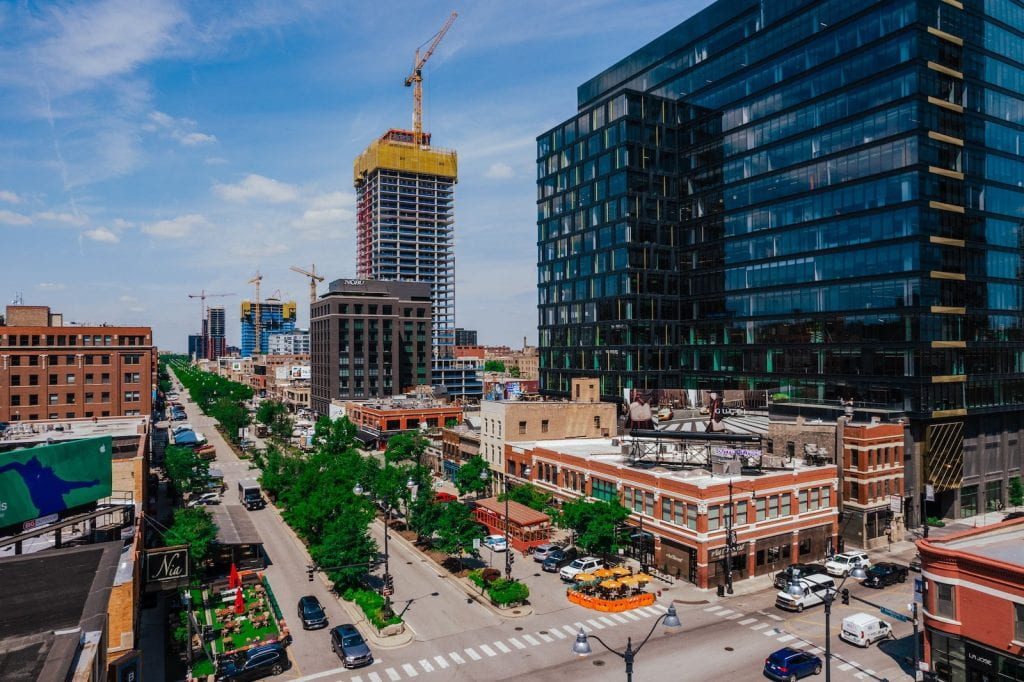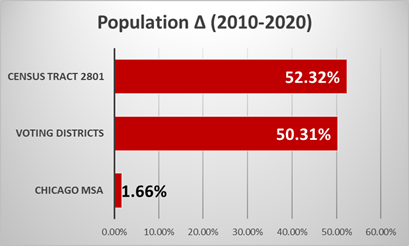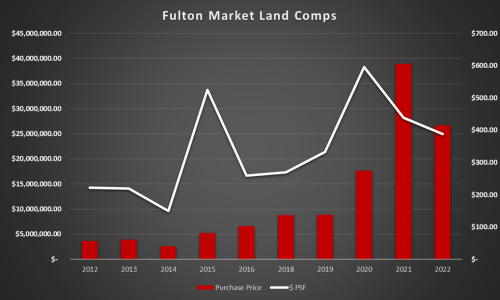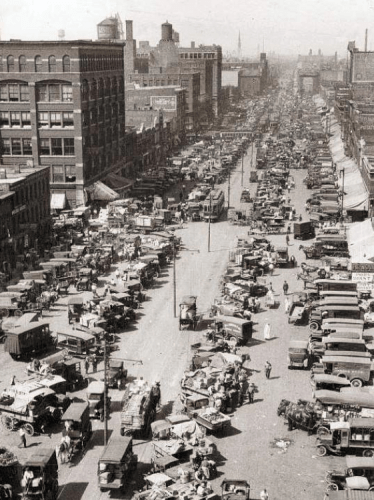
In 1923, the Chicago City Club sponsored a competition to address “the theoretical and practical parameters, social and physical, of a micro-community in a suburban context with a focus on housing.”1 William E. Drummond, a student in the Frank Lloyd Wright studio, offered the concept of the “Neighborhood Unit.” This innovative urban design suggested that neighborhood organization should center on the proximity of residences and essential services to foster a cohesive identity and a sense of belonging in the community. Today, nearly a century later, Chicago neighborhoods are once again drawing inspiration from the principles of the Neighborhood Unit, which have evolved into the “new-urbanist” concept of the 15-minute city.

In a 2020 TED Talk, University of Paris Professor, Carlos Moreno discussed the importance of a 15-minute city. Moreno’s TED Talk comes in response to what has become many urbanists’ defining plague for modern U.S. cities: urban sprawl.2 The trend of mass migration from urban cores to suburban outskirts represents the abandonment of denser “downtown living” for spread out “cul-de-sac style” neighborhoods and houses. As a result, urban areas lose their backbone of human capital, impacting local infrastructure, businesses, social spaces, and city place-making. Moreno asserts that the “essence of […] the urban experience” should be access to work, housing, food, health, education, culture, and leisure. Moreover, Moreno outlines the guiding principles of the 15-minute city: ecology, proximity, solidarity, and participation. Phrased simply, the “live, work, play neighborhood” has become the defining terminology used by many of the place makers and developers of the neighborhoods and cities that aim to achieve this concept, one of which is a West Chicago neighborhood presently known as Fulton Market District.
The district lies directly west of the Chicago River and of Chicago’s central business district: “the loop.” The original use of the Fulton Market neighborhood was for Chicago’s meatpacking district. With a longstanding industrial identity, Chicagoans rarely considered the area a viable place to live or frequent. However, since the turn of the century, the former meatpacking district has transformed into a highly robust area with the same offerings as many of Chicago’s long-established neighborhoods. Now with many multifamily, hospitality, office, and retail offerings, and more on the way, Fulton Market continues to draw in an abundance of new residents and patrons. As a result, tenants like McDonald’s and Google have relocated to the Chicago neighborhood for their global and Midwest HQs, respectively. In doing so, whether intentionally or unintentionally, this neighborhood has become one of Chicago’s premier live, work, and play locations, and thus, well aligned with the themes of the 15-minute city. Some developers believe this was no accident.
Shapack Partners, the firm considered one of the first to begin acquiring land in the former meatpacking district, has maintained the goal of making Fulton Market a live, work, play neighborhood since they began developing there. The CEO and founder of Shapack Partners, Jeff Shapack, saw an opportunity in the Fulton Market neighborhood in the early 2000s. At the time, Fulton Market was known as the meatpacking district of the West Loop. At this stage, Shapack and other local developers recognized three advantageous driving features of the area:
(1) Fulton Market is directly adjacent to Chicago’s central business district (The Loop). This would offer downtown workers and residents an alternative neighborhood to reside.
(2) The development climate was positive toward new development. Zoned primarily as an industrial and manufacturing area, few people lived in Fulton Market, meaning there was little concern for displacement or opposition from local residents. Additionally, with many of the meatpacking and industrial businesses being wholesalers, the neighborhood contributed little to the city’s bottom line in sales tax.
(3) Fulton Market was well positioned within Chicago’s transit system. The neighborhood is directly north of Chicago’s Union Station and has multiple major subway lines with stops in Fulton Market. By identifying and demonstrating these characteristics, Shapack and the other stakeholders in Fulton Market were able to minimize potential issues with community and municipal acceptance of their concept.
Success of Fulton Market
Since developers began to target the neighborhood in the early 2000s, Fulton Market has been consistently cited as one of the fastest-growing neighborhoods in the U.S.3 This is evident in Fulton Market’s population growth, asset/land value appreciation, tenants, and land usage.
Population
The “Fulton Market Innovation District” plan was adopted by the City of Chicago in 2014. Thus, for the purpose of this research, it is necessary to consider the surrounding and underlying neighborhoods and communities in the Fulton Market scope. The nearby neighborhoods on the Westside of Chicago and the overarching area surrounding Fulton Market is known as the “Near West Side.” Between 2010 and 2017, the Near West Side population grew by more than 14%, while the City of Chicago grew by only 1%.4
Census tract 2801 covers a significant portion of the core of Fulton Market. With a population of 4,872 and 7,421 in 2010 and 2020, respectively, tract 2801 grew in population by 52%. The voting districts of the encompassing general Fulton Market grew by similar margins, with the population expanding from 4,617 to 6,940 in the same period. All the while, the Chicago metropolitan statistical area grew by only 2%.

Land & Asset Value
Between 2014 and 2020, 43 projects valued at 14 billion USD received approval in the Fulton Market District.4 Since the turn of the century and throughout this period, land and asset values have grown rapidly. For example, 914-26 W. Fulton sold for $1.55 million in 2000 and then $14.5 million in 2016. The site is now home to Fulton Market’s “Time Out Market”, a popular food hall with 18 eateries, three bars, a demo kitchen, and a rooftop terrace. Additionally, 811 W. Fulton, a 64,877 square foot mixed-use building, was purchased for $2.63 million in 2014 and sold for $50.3 million in 2019.

Overall, asset and land values have increased significantly over the last decade. As evident in Figure 2, Fulton Market’s average acquisition price has quadrupled from 2019 to 2021, while the average cost per square foot has more than doubled in the same period of time. Since developers began moving into the former meatpacking district around 2010, competition for the land has grown steadily. The 2014 implementation of the Fulton Market Innovation District bolstered this competition. Since then, prominent Chicago and U.S. developers and investors have pushed to get in on the action in the neighborhood. In addition to Shapack Partners, other major neighborhood developers, and investors include, but are not limited to, Sterling Bay, Walton Street Capital, Crow Holdings, Related Companies, and Fulton St Companies.
Tenants
Since developers began bringing in the necessary commercial space, major tenants across all asset classes began moving in to take advantage of the fast-growing neighborhood. On the office side, with HQ tenants like Dyson and McDonald’s joining Fulton Market between 2017 and 2018, the neighborhood has recently welcomed new occupants like Google (2019) for their U.S. headquarters and Oreo-maker: Mondelez (2020) for their global headquarters. Additionally, WeWork, the coworking office rental company, has opened 3 Chicago offices in Fulton Market since 2014. Shifting to hospitality, between 2014 and 2020, Fulton Market developers added 1,702 hotel keys. Of those additions, major brands include globally recognized hotels and private clubs: Soho House, Nobu, London-based hotel: The Hoxton, and The Ambassador. Lastly, on the retail end, major global and national brands have opened up shops and distribution centers in Fulton Market in the last decade. These include, but are not limited to, Apple Inc., Lululemon Athletica, Specialized, Allbirds, Warby Parker, Whole Foods, Trader Joes, and Guinness. The furthest distance between the offerings mentioned above is 0.75 miles. To bolster much of the retail and restaurant tenancy, firms are shifting their focus to bring more residential offerings to the area. Most recently, Related Midwest aims for a June 2023 opening of what will become the tallest building in Fulton Market, “The Row Fulton Market”, a 43-story 300 unit residential building.
Usage
None of the development and eventual growth could have been achieved without municipal approval and changes in land use. As mentioned, Fulton Market was originally Chicago’s meatpacking and industrial district. Therefore, industrial and manufacturing use comprised much of the zoning classification of the area. In 2014, after developers had already begun buying up and developing some of the land, Chicago’s Department of Planning and Development began its land use plan analysis of the neighborhood’s historic and cultural importance in conjunction with the opportunities of the neighborhood (location, development climate, and transit orientation).

As a result, the land-use allowances and development climate shifted in favor of the growth and historical preservation of the Fulton Market. “Based on the recommendations in that plan, the City designated a landmark district to preserve the historic assets at the core of the [Fulton Market Innovation District], [and] updated the zoning code to remove the Planned Manufacturing District within the FMID to allow for a variety of commercial uses.”4
Fulton Market as a 15-Minute Neighborhood
Since implementing the FMID, the City of Chicago has approved over 50 neighborhood projects, with more on the way. Between 2010-2020, the population in the neighborhood has roughly doubled, with the majority of residents being young professionals between the ages of 20-34. Moreover, most households are single, while 36.6% are families. In roughly the same time frame, about 58% of “Near West Side” residents used public transit, bikes, or walked to work. Moreover, from 2018 to 2019, the primary transit station in Fulton Market, the Morgan station, saw a 5.6% increase in ridership.4
The idea behind the 15-minute city is to reduce reliance on cars and enable more efficient use of urban resources, such as land and energy. This is achieved by positioning essential services, such as schools, health centers, grocery stores, and other everyday services across each neighborhood, making them easily and quickly accessible to the majority of the neighborhood residents. In the case of Fulton Market, employment growing in conjunction with the population as an apparent result of the neighborhood firms, coupled with the majority of residents not requiring a car to get to work, is evidence of a “live, work, play” environment. Examining these changes in keeping with one another indicates the successful implementation of Fulton Market as a 15-Minute City.
Key evidence lies not only with what happened in the neighborhood, but also with what is happening outside of it. Just north of where the Fulton Market Innovation District ends, according to the Chicago Department of Planning and Development, Shapack partners has achieved approval for its master-planned development “North of Milwaukee Avenue” (NOMA). This 3.25-acre master plan would bring in a new hotel, 1,500 residential units, and more commercial space for dining and retail.5 This indicates that the neighborhood has become so attractive to prospective residents that the bordering areas need to offer the capacity to take in the overflow from Fulton Market. Of course, this will likely not be the only major planned development in, or just outside of, Fulton Market in the foreseeable future. The overall success of Fulton Market and the FMID will likely continue to grow for several years.

Reference List






